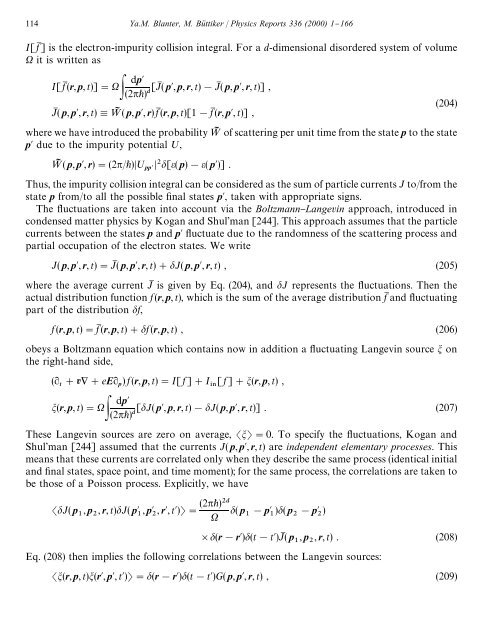shot noise in mesoscopic conductors - Low Temperature Laboratory
shot noise in mesoscopic conductors - Low Temperature Laboratory
shot noise in mesoscopic conductors - Low Temperature Laboratory
Create successful ePaper yourself
Turn your PDF publications into a flip-book with our unique Google optimized e-Paper software.
114 Ya.M. Blanter, M. Bu( ttiker / Physics Reports 336 (2000) 1}166<br />
I[ fM ] is the electron-impurity collision <strong>in</strong>tegral. For a d-dimensional disordered system of volume<br />
it is written as<br />
dp<br />
I[ fM (r, p, t)]" [JM ( p, p, r, t)!JM ( p, p, r, t)] ,<br />
(2) (204)<br />
JM ( p, p, r, t),=I ( p, p, r) fM (r, p, t)[1!fM (r, p, t)] ,<br />
where we have <strong>in</strong>troduced the probability =I of scatter<strong>in</strong>g per unit time from the state p to the state<br />
p due to the impurity potential ;,<br />
=I ( p, p, r)"(2/); pp [( p)!( p)] .<br />
Thus, the impurity collision <strong>in</strong>tegral can be considered as the sum of particle currents J to/from the<br />
state p from/to all the possible "nal states p, taken with appropriate signs.<br />
The #uctuations are taken <strong>in</strong>to account via the Boltzmann}Langev<strong>in</strong> approach, <strong>in</strong>troduced <strong>in</strong><br />
condensed matter physics by Kogan and Shul'man [244]. This approach assumes that the particle<br />
currents between the states p and p #uctuate due to the randomness of the scatter<strong>in</strong>g process and<br />
partial occupation of the electron states. We write<br />
J( p, p, r, t)"JM ( p, p, r, t)#J( p, p, r, t) , (205)<br />
where the average current JM is given by Eq. (204), and J represents the #uctuations. Then the<br />
actual distribution function f (r, p, t), which is the sum of the average distribution fM and #uctuat<strong>in</strong>g<br />
part of the distribution f,<br />
f (r, p, t)"fM (r, p, t)#f (r, p, t) , (206)<br />
obeys a Boltzmann equation which conta<strong>in</strong>s now <strong>in</strong> addition a #uctuat<strong>in</strong>g Langev<strong>in</strong> source on<br />
the right-hand side,<br />
(R #*#eER p) f (r, p, t)"I[ f ]#I [ f ]#(r, p, t) ,<br />
dp<br />
(r, p, t)" [J( p, p, r, t)!J( p, p, r, t)] . (207)<br />
(2) These Langev<strong>in</strong> sources are zero on average, "0. To specify the #uctuations, Kogan and<br />
Shul'man [244] assumed that the currents J( p, p, r, t) are <strong>in</strong>dependent elementary processes. This<br />
means that these currents are correlated only when they describe the same process (identical <strong>in</strong>itial<br />
and "nal states, space po<strong>in</strong>t, and time moment); for the same process, the correlations are taken to<br />
be those of a Poisson process. Explicitly, we have<br />
J( p , p , r, t)J( p , p , r, t)"<br />
(2)<br />
( p !p )( p !p )<br />
(r!r)(t!t)JM ( p , p , r, t) . (208)<br />
Eq. (208) then implies the follow<strong>in</strong>g correlations between the Langev<strong>in</strong> sources:<br />
(r, p, t)(r, p, t)"(r!r)(t!t)G( p, p, r, t) , (209)
















